Connect With Us
Blog
Blog
Why Are My Feet Cold?
 The feet may feel cold when there are environmental stresses, such as the temperature dropping. This may cause oxygen deficiency and turn the feet blue in color, a condition called cyanosis. When the natural circulation is restored, this condition disappears. There are other causes of poor blood circulation, including the inability to produce normal levels of red blood cells, commonly known as anemia. Typically, improvement may be achieved through diet, in addition to taking nutritional supplements. Diabetes may be another cause, and this disease can have very serious effects on the feet. It may result in nerve damage, causing the feet to feel cold. If your feet feel cold a lot of the time, a consultation with a podiatrist may be advised.
The feet may feel cold when there are environmental stresses, such as the temperature dropping. This may cause oxygen deficiency and turn the feet blue in color, a condition called cyanosis. When the natural circulation is restored, this condition disappears. There are other causes of poor blood circulation, including the inability to produce normal levels of red blood cells, commonly known as anemia. Typically, improvement may be achieved through diet, in addition to taking nutritional supplements. Diabetes may be another cause, and this disease can have very serious effects on the feet. It may result in nerve damage, causing the feet to feel cold. If your feet feel cold a lot of the time, a consultation with a podiatrist may be advised.
Poor circulation is a serious condition and needs immediate medical attention. If you have any concerns with poor circulation in your feet contact Dr. Harry I. Zirna of Lockport Foot Care, PLLC. Dr. Zirna will treat your foot and ankle needs.
Poor Circulation in the Feet
Poor blood circulation in the feet and legs is can be caused by peripheral artery disease (PAD), which is the result of a buildup of plaque in the arteries.
Plaque buildup or atherosclerosis results from excess calcium and cholesterol in the bloodstream. This can restrict the amount of blood which can flow through the arteries. Poor blood circulation in the feet and legs are sometimes caused by inflammation in the blood vessels, known as vasculitis.
Causes
Lack of oxygen and oxygen from poor blood circulation restricts muscle growth and development. It can also cause:
- Muscle pain, stiffness, or weakness
- Numbness or cramping in the legs
- Skin discoloration
- Slower nail & hair growth
- Erectile dysfunction
Those who have diabetes or smoke are at greatest risk for poor circulation, as are those who are over 50. If you have poor circulation in the feet and legs it may be caused by PAD and is important to make changes to your lifestyle in order to reduce risk of getting a heart attack or stroke. Exercise and maintaining a healthy lifestyle will dramatically improve conditions.
As always, see a podiatrist as he or she will assist in finding a regimen that suits you. A podiatrist can also prescribe you any needed medication.
If you have any questions please feel free to contact our offices located in Lockport and Medina, NY. We offer the newest diagnostic and treatment technologies for all your foot and ankle needs.
Read more about Causes, Symptoms, and Treatment of Poor Blood Circulation in the FeetVikings DE Everson Griffen Experiencing Plantar Fasciitis
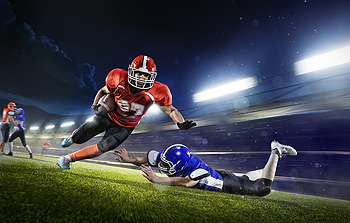 Defensive end Everson Griffen of the Minnesota Vikings has been playing while suffering from plantar fasciitis. Plantar fasciitis is the inflammation of the plantar fascia in the bottom of the foot. This condition can cause intense pain to those who have it. The pain hasn’t slowed Griffen down though, as he is ranked third in the league with 13.0 sacks, a career high for him.
Defensive end Everson Griffen of the Minnesota Vikings has been playing while suffering from plantar fasciitis. Plantar fasciitis is the inflammation of the plantar fascia in the bottom of the foot. This condition can cause intense pain to those who have it. The pain hasn’t slowed Griffen down though, as he is ranked third in the league with 13.0 sacks, a career high for him.
Sports related foot and ankle injuries require proper treatment before players can go back to their regular routines. For more information, contact Dr. Harry I. Zirna of Lockport Foot Care, PLLC. Dr. Zirna can provide the care you need to keep you pain-free and on your feet.
Sports Related Foot and Ankle Injuries
Foot and ankle injuries are a common occurrence when it comes to athletes of any sport. While many athletes dismiss the initial aches and pains, the truth is that ignoring potential foot and ankle injuries can lead to serious problems. As athletes continue to place pressure and strain the area further, a mild injury can turn into something as serious as a rupture and may lead to a permanent disability. There are many factors that contribute to sports related foot and ankle injuries, which include failure to warm up properly, not providing support or wearing bad footwear. Common injuries and conditions athletes face, including:
- Plantar Fasciitis
- Plantar Fasciosis
- Achilles Tendinitis
- Achilles Tendon Rupture
- Ankle Sprains
Sports related injuries are commonly treated using the RICE method. This includes rest, applying ice to the injured area, compression and elevating the ankle. More serious sprains and injuries may require surgery, which could include arthroscopic and reconstructive surgery. Rehabilitation and therapy may also be required in order to get any recovering athlete to become fully functional again. Any unusual aches and pains an athlete sustains must be evaluated by a licensed, reputable medical professional.
If you have any questions please feel free to contact our offices located in Lockport and Medina, NY. We offer the newest diagnostic and treatment technologies for all your foot and ankle needs.
Read more about Sports Related Foot And Ankle InjuriesHow to Tell if You Have a Broken Toe
 While it might seem obvious when and if you have a broken toe, this is not always the case. While some may experience crippling pain that causes them to stop walking, others may not experience pain at all. Pain, swelling, bruising, and tenderness are common signs of a broken toe. You may experience pain for weeks; if you do, you should see a podiatrist as soon as possible. Another sign can be if you hear a popping sound at the moment you hit your toe against something. The most obvious sign is if bone is protruding out of the skin. In any case, it is important that you get checked out if you believe you have a broken toe, as the toe requires proper care if it is going to heal properly.
While it might seem obvious when and if you have a broken toe, this is not always the case. While some may experience crippling pain that causes them to stop walking, others may not experience pain at all. Pain, swelling, bruising, and tenderness are common signs of a broken toe. You may experience pain for weeks; if you do, you should see a podiatrist as soon as possible. Another sign can be if you hear a popping sound at the moment you hit your toe against something. The most obvious sign is if bone is protruding out of the skin. In any case, it is important that you get checked out if you believe you have a broken toe, as the toe requires proper care if it is going to heal properly.
A broken toe can be very painful and lead to complications if not properly fixed. If you have any concerns about your feet, contact Dr. Harry I. Zirna from Lockport Foot Care, PLLC. Dr. Zirna will treat your foot and ankle needs.
What to Know About a Broken Toe
Although most people try to avoid foot trauma such as banging, stubbing, or dropping heavy objects on their feet, the unfortunate fact is that it is a common occurrence. Given the fact that toes are positioned in front of the feet, they typically sustain the brunt of such trauma. When trauma occurs to a toe, the result can be a painful break (fracture).
Symptoms of a Broken Toe
- Throbbing pain
- Swelling
- Bruising on the skin and toenail
- The inability to move the toe
- Toe appears crooked or disfigured
- Tingling or numbness in the toe
Generally, it is best to stay off of the injured toe with the affected foot elevated.
Severe toe fractures may be treated with a splint, cast, and in some cases, minor surgery. Due to its position and the pressure it endures with daily activity, future complications can occur if the big toe is not properly treated.
If you have any questions please feel free to contact our offices located in Lockport and Medina, NY. We offer the newest diagnostic and treatment technologies for all your foot and ankle needs.
Read more about What to Know About a Broken ToeHow Rheumatoid Arthritis Can Affect the Feet
 Rheumatoid arthritis is a chronic inflammatory disease that causes swelling in the heel and joints and can be very painful. It commonly affects the small joints of the feet. Corns and hammertoes can develop, and bunions may be exacerbated due to the weakened ligaments in the foot. Common symptoms that may occur include clicking and popping sounds, locked joints due to stiffness, and difficulty walking. Plantar fasciitis can also develop because the tissue that runs along the bottom of the foot becomes inflamed. Stretching exercises, which increases the flexibility of the foot and toes, can help bring some relief. Additionally, wearing comfortable and supportive shoes may also make your feet feel better. Avoid poorly-fitted footwear such as high heels, as they increase pressure on the feet. Please consult with a podiatrist for a proper diagnosis if you have pain in your feet. Podiatrists are trained to handle arthritis in the foot and ankle and will be able to help with the condition.
Rheumatoid arthritis is a chronic inflammatory disease that causes swelling in the heel and joints and can be very painful. It commonly affects the small joints of the feet. Corns and hammertoes can develop, and bunions may be exacerbated due to the weakened ligaments in the foot. Common symptoms that may occur include clicking and popping sounds, locked joints due to stiffness, and difficulty walking. Plantar fasciitis can also develop because the tissue that runs along the bottom of the foot becomes inflamed. Stretching exercises, which increases the flexibility of the foot and toes, can help bring some relief. Additionally, wearing comfortable and supportive shoes may also make your feet feel better. Avoid poorly-fitted footwear such as high heels, as they increase pressure on the feet. Please consult with a podiatrist for a proper diagnosis if you have pain in your feet. Podiatrists are trained to handle arthritis in the foot and ankle and will be able to help with the condition.
Because RA affects more than just your joints, including the joints in your feet and ankles, it is important to seek early diagnosis from your podiatrist if you feel like the pain in your feet might be caused by RA. For more information, contact Dr. Harry I. Zirna of Lockport Foot Care, PLLC. Dr. Zirna will assist you with all of your podiatric concerns.
What Is Rheumatoid Arthritis?
Rheumatoid Arthritis (RA) is an autoimmune disorder in which the body’s own immune system attacks the membranes surrounding the joints. Inflammation of the lining and eventually the destruction of the joint’s cartilage and bone occur, causing severe pain and immobility.
Rheumatoid Arthritis of the Feet
Although RA usually attacks multiple bones and joints throughout the entire body, almost 90 percent of cases result in pain in the foot or ankle area.
Symptoms
- Swelling and pain in the feet
- Stiffness in the feet
- Pain on the ball or sole of feet
- Joint shift and deformation
Diagnosis
Quick diagnosis of RA in the feet is important so that the podiatrist can treat the area effectively. Your doctor will ask you about your medical history, occupation, and lifestyle to determine the origin of the condition. Rheumatoid Factor tests help to determine if someone is affected by the disease.
If you have any questions please feel free to contact our offices located in Lockport and Medina, NY. We offer the newest diagnostic and treatment technologies for all your foot and ankle needs.
Read more about Rheumatoid Arthritis in the FeetCommon Running Injuries and How to Prevent Them
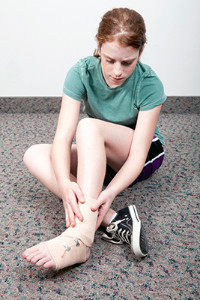 Runners often face a number of common injuries that can range from generally mild to serious. Here are several common injuries and what you can do to treat and prevent them. Achilles tendonitis is the inflammation of the Achilles tendon and can range in severity. If you feel pain in the back of your foot, it is advised to stop running and to rest while applying ice to the area; this will combat inflammation. Seeing a podiatrist for tendonitis is recommended, especially if you are in pain. Stress fractures are tiny hairline fractures that occur in the bone, and they often stem from overuse. Making sure not to push yourself too hard during sports or exercise is a good way to help prevent them. Be sure to see a podiatrist if you are experiencing pain in your foot and suspect it is a stress fracture. An ankle sprain is another common running injury and often occurs from landing improperly. While one could rest and use ice to treat a mild case of tendonitis or a stress fracture, it is highly recommended to see a podiatrist for an ankle sprain.
Runners often face a number of common injuries that can range from generally mild to serious. Here are several common injuries and what you can do to treat and prevent them. Achilles tendonitis is the inflammation of the Achilles tendon and can range in severity. If you feel pain in the back of your foot, it is advised to stop running and to rest while applying ice to the area; this will combat inflammation. Seeing a podiatrist for tendonitis is recommended, especially if you are in pain. Stress fractures are tiny hairline fractures that occur in the bone, and they often stem from overuse. Making sure not to push yourself too hard during sports or exercise is a good way to help prevent them. Be sure to see a podiatrist if you are experiencing pain in your foot and suspect it is a stress fracture. An ankle sprain is another common running injury and often occurs from landing improperly. While one could rest and use ice to treat a mild case of tendonitis or a stress fracture, it is highly recommended to see a podiatrist for an ankle sprain.
Exercising your feet regularly with the proper foot wear is a great way to prevent injuries. If you have any concerns about your feet, contact Dr. Harry I. Zirna of Lockport Foot Care, PLLC. Dr. Zirna will treat your foot and ankle needs.
How to Prevent Running Injuries
Many common running injuries are caused by overuse and overtraining. When the back of the kneecap starts wearing out and starts causing pain in your knee, this is commonly referred to as runner’s knee. Runner’s knee is a decrease in strength in your quadriceps and can occur if you’re not wearing properly fitted or supporting shoes. To prevent runner’s knee, focusing on hip strengthening is a good idea, as well as strengthening your quads to keep the kneecaps aligned.
What Are Some Causes of Running Injuries?
- One cause of a common running injury is called iliotibial band syndrome.
- Plantar fasciitis is also another common injury.
- Stress fractures can occur from overtraining, lack of calcium, or even your running style.
Best Ways to Prevent Running Injuries
- Wear footwear that fits properly and suits your running needs.
- Running shoes are the only protective gear that runners have to safeguard them from injury.
- Make a training schedule. Adding strengthening exercises as well as regular stretching can help keep you strong and limber and can lessen the possibility of injuries.
- Stretching keeps muscles limber; this will help you gain better flexibility.
If you have any questions please feel free to contact our offices located in Lockport and Medina, NY. We offer the newest diagnostic and treatment technologies for all your foot and ankle needs.
Read more about How to Prevent Running InjuriesHow Blisters Can be Prevented
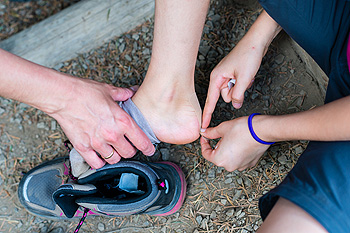 When you increase the amount of friction on the foot, you also increase the risk of getting blisters. Blisters can originate from many sources, including socks, sweat, shoes and restricted foot motion. It’s important to have adequate toe room in the shoe; this can lessen friction, therefore preventing blisters. When proper insoles are worn, fewer blisters may occur. Additionally, wearing the correct socks, such as synthetic or wool socks, can be important in reducing skin friction. Sweat can also be a factor in producing blisters and typically happens in the warmer months. Using an antiperspirant may aid in producing less sweat, and fewer blisters may occur.
When you increase the amount of friction on the foot, you also increase the risk of getting blisters. Blisters can originate from many sources, including socks, sweat, shoes and restricted foot motion. It’s important to have adequate toe room in the shoe; this can lessen friction, therefore preventing blisters. When proper insoles are worn, fewer blisters may occur. Additionally, wearing the correct socks, such as synthetic or wool socks, can be important in reducing skin friction. Sweat can also be a factor in producing blisters and typically happens in the warmer months. Using an antiperspirant may aid in producing less sweat, and fewer blisters may occur.
Blisters are prone to making everyday activities extremely uncomfortable. If your feet are hurting, contact Dr. Harry I. Zirna of Lockport Foot Care, PLLC. Dr. Zirna can provide the care you need to keep you pain-free and on your feet.
Foot Blisters
Foot blisters develop as a result of constantly wearing tight or ill-fitting footwear. This happens due to the constant rubbing from the shoe, which can often lead to pain.
What Are Foot Blisters?
A foot blister is a small fluid-filled pocket that forms on the upper-most layer of the skin. Blisters are filled with clear fluid and can lead to blood drainage or pus if the area becomes infected.
How Do Blisters Form?
Blisters on the feet are often the result of constant friction of skin and material, usually by shoe rubbing. Walking in sandals, boots, or shoes that don’t fit properly for long periods of time can result in a blister. Having consistent foot moisture and humidity can easily lead to blister formation.
Prevention & Treatment
It is important to properly care for the affected area in order to prevent infection and ease the pain. Do not lance the blister and use a Band-Aid to provide pain relief. Also, be sure to keep your feet dry and wear proper fitting shoes. If you see blood or pus in a blister, seek assistance from a podiatrist.
If you have any questions, please feel free to contact our offices located in Lockport and Medina, NY. We offer the newest diagnostic and treatment technologies for all your foot care needs.
Read more about Blisters on the FeetCommon Foot Symptoms and What They Might Mean
 Our feet are extremely important and allow us to do so much with our lives. Making sure our feet are healthy and being on the lookout for any potential ailments is recommended. Here are some relatively common foot symptoms and what they might mean. If you are experiencing tingling sensations in your feet, it may be a sign of diabetes. A common condition caused by diabetes is neuropathy, which damages the nerves in our body, especially in the legs and feet. If your toes are numb, that can also be a cause of neuropathy or Raynaud’s disease, a condition which causes poor circulation in the hands and feet. It may also be a sign that your feet are cold, so be sure to keep them warm in cold weather. Finally, if your nails are brittle, it may be a sign of vitamin deficiency or of toenail fungus. In all these cases, it is recommended to see a podiatrist since they could be symptoms of serious conditions.
Our feet are extremely important and allow us to do so much with our lives. Making sure our feet are healthy and being on the lookout for any potential ailments is recommended. Here are some relatively common foot symptoms and what they might mean. If you are experiencing tingling sensations in your feet, it may be a sign of diabetes. A common condition caused by diabetes is neuropathy, which damages the nerves in our body, especially in the legs and feet. If your toes are numb, that can also be a cause of neuropathy or Raynaud’s disease, a condition which causes poor circulation in the hands and feet. It may also be a sign that your feet are cold, so be sure to keep them warm in cold weather. Finally, if your nails are brittle, it may be a sign of vitamin deficiency or of toenail fungus. In all these cases, it is recommended to see a podiatrist since they could be symptoms of serious conditions.
Everyday foot care is very important to prevent infection and other foot ailments. If you need your feet checked, contact Dr. Harry I. Zirna from Lockport Foot Care, PLLC. Dr. Zirna can provide the care you need to keep you pain-free and on your feet.
Everyday Foot Care
Often, people take care of their bodies, face and hair more so than they do for their feet. But the feet are a very important aspect of our bodies, and one that we should pay more attention to. Without our feet, we would not be able to perform most daily tasks.
It is best to check your feet regularly to make sure there are no new bruises or cuts that you may not have noticed before. For dry feet, moisturizer can easily be a remedy and can be applied as often as necessary to the affected areas. Wearing shoes that fit well can also help you maintain good foot health, as well as making it easier to walk and do daily activities without the stress or pain of ill-fitting shoes, high heels, or even flip flops. Wearing clean socks with closed shoes is important to ensure that sweat and bacteria do not accumulate within the shoe. Clean socks help to prevent Athlete’s foot, fungi problems, bad odors, and can absorb sweat.
If you have any questions please feel free to contact our offices located in Lockport and Medina, NY. We offer the newest diagnostic and treatment technologies for all your foot and ankle needs.
Read more about Every Day Foot CareFinding the Right Pair of Training Shoes for You
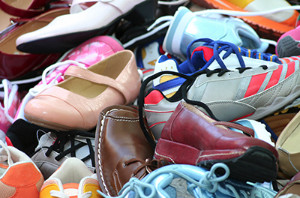 Exercising is a great way to stay healthy. Depending on the way you exercise, different shoes may be better for you. When shopping for shoes, go later in the day because your foot tends to swell throughout the day. Try on different brands and pairs, as every shoe is different. Things to look for include space for your toes to wiggle around, support for your foot, and comfort when worn for long periods of time. If the shoes are heavy, do not provide enough room, or do not provide support, it is recommended to try finding a different pair. Finally, wear whatever socks you plan on wearing when you workout. This will negate the question later on of whether your socks cause your shoes to fit too small.
Exercising is a great way to stay healthy. Depending on the way you exercise, different shoes may be better for you. When shopping for shoes, go later in the day because your foot tends to swell throughout the day. Try on different brands and pairs, as every shoe is different. Things to look for include space for your toes to wiggle around, support for your foot, and comfort when worn for long periods of time. If the shoes are heavy, do not provide enough room, or do not provide support, it is recommended to try finding a different pair. Finally, wear whatever socks you plan on wearing when you workout. This will negate the question later on of whether your socks cause your shoes to fit too small.
Finding a properly-fitting shoe is important in reducing injuries and preventing foot problems. For more information about treatment, contact Dr. Harry I. Zirna from Lockport Foot Care, PLLC. Dr. Zirna will treat your foot and ankle needs.
Proper Shoe Fitting
A common concern when it comes to foot health, having properly fitted shoes can help prevent injuries to the foot. Out feet affect our posture and gait, which in turn affects the biomechanics and overall bodily structure. With 33 joints, 26 bones, and over 100 ligaments, the potential for serious injury is much greater than one realizes. Although the feet cease growth in adulthood, they still change shape as they mature. Here are some factors to consider when it comes to investing in proper fitting shoes:
- Be sure the shoes fit correctly right away
- Ensure the ball of your foot fits comfortably in the widest portion of the shoes
- Even though they may look fashionable, improper fitting shoes can either create adverse conditions or exacerbate existing ones you may already have
- Walk along a carpeted surface to ensure the shoes comfortably fit during normal activity
Keeping in mind how shoes fit the biomechanics of your body, properly-fitting shoes are vitally important. Fortunately, it is not difficult to acquire footwear that fits correctly. Be sure to wear shoes that support the overall structure of your body. Do your feet a favor and invest in several pairs of well-fitted shoes today.
If you have any questions please feel free to contact our offices located in Lockport and Medina, NY. We offer the newest diagnostic and treatment technologies for all your foot and ankle needs.
Read more about Proper Shoe FittingCold Feet and Blood Circulation
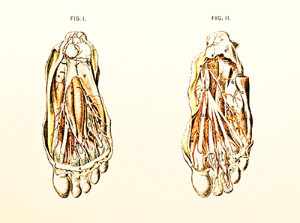 While most people have experienced cold feet at some point in their life, some experience it during times when the weather isn’t necessarily cold. This can be due to poor blood circulation, which in itself can be caused by a number of conditions. Some of these conditions can include anemia, diabetes, hypothyroidism, and peripheral vascular disease, among others. If your feet are cold frequently or have been cold for a long time, it is strongly recommended to see a podiatrist who can diagnose your condition. The podiatrist may have to utilize several tests to determine the exact cause. Once a cause is found, treatment will vary depending upon the condition.
While most people have experienced cold feet at some point in their life, some experience it during times when the weather isn’t necessarily cold. This can be due to poor blood circulation, which in itself can be caused by a number of conditions. Some of these conditions can include anemia, diabetes, hypothyroidism, and peripheral vascular disease, among others. If your feet are cold frequently or have been cold for a long time, it is strongly recommended to see a podiatrist who can diagnose your condition. The podiatrist may have to utilize several tests to determine the exact cause. Once a cause is found, treatment will vary depending upon the condition.
Poor circulation is a serious condition and needs immediate medical attention. If you have any concerns with poor circulation in your feet contact Dr. Harry I. Zirna of Lockport Foot Care, PLLC. Dr. Zirna will treat your foot and ankle needs.
Poor Circulation in the Feet
Poor blood circulation in the feet and legs is can be caused by peripheral artery disease (PAD), which is the result of a buildup of plaque in the arteries.
Plaque buildup or atherosclerosis results from excess calcium and cholesterol in the bloodstream. This can restrict the amount of blood which can flow through the arteries. Poor blood circulation in the feet and legs are sometimes caused by inflammation in the blood vessels, known as vasculitis.
Causes
Lack of oxygen and oxygen from poor blood circulation restricts muscle growth and development. It can also cause:
- Muscle pain, stiffness, or weakness
- Numbness or cramping in the legs
- Skin discoloration
- Slower nail & hair growth
- Erectile dysfunction
Those who have diabetes or smoke are at greatest risk for poor circulation, as are those who are over 50. If you have poor circulation in the feet and legs it may be caused by PAD and is important to make changes to your lifestyle in order to reduce risk of getting a heart attack or stroke. Exercise and maintaining a healthy lifestyle will dramatically improve conditions.
As always, see a podiatrist as he or she will assist in finding a regimen that suits you. A podiatrist can also prescribe you any needed medication.
If you have any questions please feel free to contact our offices located in Lockport and Medina, NY. We offer the newest diagnostic and treatment technologies for all your foot and ankle needs.
Read more about Causes, Symptoms, and Treatment of Poor Blood Circulation in the FeetCeltics Forward Hayward Fractures Left Ankle
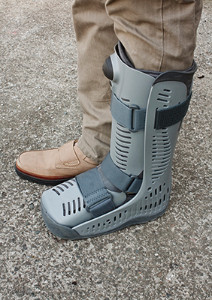 Tough break for Boston Celtics forward Gordon Hayward. Hayward badly fractured his left ankle during the Celtics and Cleveland Cavaliers game. He jumped up for a pass but collided with Lebron James and Jae Crowder. When he landed, his foot twisted and he collapsed. Hayward had signed a $128 million four year contract with the Celtics. The Celtics and Cavaliers game was his first time playing for the Celtics.
Tough break for Boston Celtics forward Gordon Hayward. Hayward badly fractured his left ankle during the Celtics and Cleveland Cavaliers game. He jumped up for a pass but collided with Lebron James and Jae Crowder. When he landed, his foot twisted and he collapsed. Hayward had signed a $128 million four year contract with the Celtics. The Celtics and Cavaliers game was his first time playing for the Celtics.
Sports related foot and ankle injuries require proper treatment before players can go back to their regular routines. For more information, contact Dr. Harry I. Zirna of Lockport Foot Care, PLLC. Dr. Zirna can provide the care you need to keep you pain-free and on your feet.
Sports Related Foot and Ankle Injuries
Foot and ankle injuries are a common occurrence when it comes to athletes of any sport. While many athletes dismiss the initial aches and pains, the truth is that ignoring potential foot and ankle injuries can lead to serious problems. As athletes continue to place pressure and strain the area further, a mild injury can turn into something as serious as a rupture and may lead to a permanent disability. There are many factors that contribute to sports related foot and ankle injuries, which include failure to warm up properly, not providing support or wearing bad footwear. Common injuries and conditions athletes face, including:
- Plantar Fasciitis
- Plantar Fasciosis
- Achilles Tendinitis
- Achilles Tendon Rupture
- Ankle Sprains
Sports related injuries are commonly treated using the RICE method. This includes rest, applying ice to the injured area, compression and elevating the ankle. More serious sprains and injuries may require surgery, which could include arthroscopic and reconstructive surgery. Rehabilitation and therapy may also be required in order to get any recovering athlete to become fully functional again. Any unusual aches and pains an athlete sustains must be evaluated by a licensed, reputable medical professional.
If you have any questions please feel free to contact our offices located in Lockport and Medina, NY. We offer the newest diagnostic and treatment technologies for all your foot and ankle needs.
Read more about Sports Related Foot And Ankle InjuriesMore...
Diet and Gout
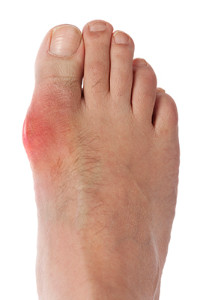 Gout, a form of arthritis caused by uric acid crystals forming in joints, can be very painful and can occur in any joint in the body. Thankfully, gout can be managed with a good diet. Avoiding high intakes of acid-rich food is advised. Purines, which are converted into uric acid by the body, come from animal and plant foods. Purine-rich diets, especially from meat and seafood, increase the risk of gout attacks. While not completely preventing gout attacks, diets with plenty of vegetables do help. Low-fat dairy products have been found to prevent uric acid buildup as well. Alcohol has also been linked with dramatically increased rates of gout attacks, so cutting back on alcohol is a great way to prevent gout attacks. While improving your diet won’t eliminate gout, it will certainly help to lessen attacks and their effects.
Gout, a form of arthritis caused by uric acid crystals forming in joints, can be very painful and can occur in any joint in the body. Thankfully, gout can be managed with a good diet. Avoiding high intakes of acid-rich food is advised. Purines, which are converted into uric acid by the body, come from animal and plant foods. Purine-rich diets, especially from meat and seafood, increase the risk of gout attacks. While not completely preventing gout attacks, diets with plenty of vegetables do help. Low-fat dairy products have been found to prevent uric acid buildup as well. Alcohol has also been linked with dramatically increased rates of gout attacks, so cutting back on alcohol is a great way to prevent gout attacks. While improving your diet won’t eliminate gout, it will certainly help to lessen attacks and their effects.
Gout is a foot condition that requires certain treatment and care. If you are seeking treatment, contact Dr. Harry I. Zirna from Lockport Foot Care, PLLC. Dr. Zirna will treat your foot and ankle needs.
What Is Gout?
Gout is a type of arthritis caused by a buildup of uric acid in the bloodstream. It often develops in the foot, especially the big toe area, although it can manifest in other parts of the body as well. Gout can make walking and standing very painful and is especially common in diabetics and the obese.
People typically get gout because of a poor diet. Genetic predisposition is also a factor. The children of parents who have had gout frequently have a chance of developing it themselves.
Gout can easily be identified by redness and inflammation of the big toe and the surrounding areas of the foot. Other symptoms include extreme fatigue, joint pain, and running high fevers. Sometimes corticosteroid drugs can be prescribed to treat gout, but the best way to combat this disease is to get more exercise and eat a better diet.
If you have any questions please feel free to contact our offices located in Lockport and Medina, NY. We offer the newest diagnostic and treatment technologies for all your foot and ankle needs.
Read more about Everything You Need to Know About GoutWhat to Look for in Children’s Shoes
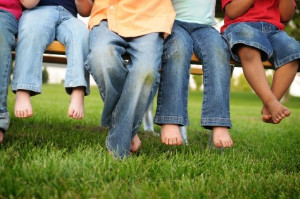 Choosing the right pair of shoes is essential for children. This is due to the fact that children’s feet are still developing, so shoes that aren’t of good quality or fit can potentially create foot problems. When shopping for shoes for your children, make sure they fit properly and that they are durable as well. Rubber soles are recommended to provide good grip and prevent falls. Ensure that the toe-box provides enough wiggle room for their toes and that shoes are made of breathable materials like leather or mesh. Shoes should be stiff where the sole thickens, but flexible where the toes are. It may be tempting to buy shoes that are bigger so that their feet will grow into them, but this could lead to tripping and potential injury. Every child is different, so taking your child to get properly fitted is always recommended.
Choosing the right pair of shoes is essential for children. This is due to the fact that children’s feet are still developing, so shoes that aren’t of good quality or fit can potentially create foot problems. When shopping for shoes for your children, make sure they fit properly and that they are durable as well. Rubber soles are recommended to provide good grip and prevent falls. Ensure that the toe-box provides enough wiggle room for their toes and that shoes are made of breathable materials like leather or mesh. Shoes should be stiff where the sole thickens, but flexible where the toes are. It may be tempting to buy shoes that are bigger so that their feet will grow into them, but this could lead to tripping and potential injury. Every child is different, so taking your child to get properly fitted is always recommended.
Making sure that your children maintain good foot health is very important as they grow. If you have any questions, contact Dr. Harry I. Zirna of Lockport Foot Care, PLLC. Dr. Zirna can provide the care you need to keep you pain-free and on your feet.
Keeping Children's Feet Healthy
Having healthy feet during childhood can help prevent medical problems later in life, namely in the back and legs. As children grow, their feet require different types of care. Here are some things to consider...
Although babies do not walk yet, it is still very important to take care of their feet.
Avoid putting tight shoes or socks on his or her feet.
Allow the baby to stretch and kick his or her feet to feel comfortable.
As a toddler, kids are now on the move and begin to develop differently. At this age, toddlers are getting a feel for walking, so don’t be alarmed if your toddler is unsteady or ‘walks funny’.
As your child gets older, it is important to teach them how to take care of their feet.
Show them proper hygiene to prevent infections such as fungus.
Be watchful for any pain or injury.
Have all injuries checked by a doctor as soon as possible.
Comfortable, protective shoes should always be worn, especially at play.
If you have any questions please feel free to contact our offices located in Lockport and Medina, NY. We offer the newest diagnostic and treatment technologies for all your foot and ankle needs.
Read more about What to Do to Keep Your Child’s Feet HealthyAre Shoe Sizes Keeping Up With Women’s Increasing Sizes?
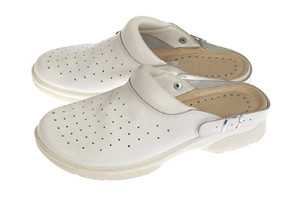 Women’s feet have increased two sizes since the 1970s, and yet their shoe sizes haven’t. Women who have larger feet are, unfortunately, left out and have few options. Some girls have resorted to wearing boys’ shoes, which are not properly fitted for women; this can lead to an increase risk of falling and other issues. Several experts blame this on overseas production and it not being cost-effective to make bigger shoes. Bigger shoes cost more to make; however, they are accounting for larger percentages in the footwear market. A few experts recommend buying from German companies, who have kept up with foot size increases. It is important that not only women, but also men, wear properly fitted shoes. Shoes that are too small can lead to issues like plantar fasciitis, corns, hammertoes, and a number of ailments that cause foot pain.
Women’s feet have increased two sizes since the 1970s, and yet their shoe sizes haven’t. Women who have larger feet are, unfortunately, left out and have few options. Some girls have resorted to wearing boys’ shoes, which are not properly fitted for women; this can lead to an increase risk of falling and other issues. Several experts blame this on overseas production and it not being cost-effective to make bigger shoes. Bigger shoes cost more to make; however, they are accounting for larger percentages in the footwear market. A few experts recommend buying from German companies, who have kept up with foot size increases. It is important that not only women, but also men, wear properly fitted shoes. Shoes that are too small can lead to issues like plantar fasciitis, corns, hammertoes, and a number of ailments that cause foot pain.
Getting the right shoe size is an important part of proper foot health. Seek the assistance of Dr. Harry I. Zirna from Lockport Foot Care, PLLC. Dr. Zirna will provide the care you need to keep you pain-free and on your feet.
Getting the Right Shoe Size
There are many people who wear shoes that are the incorrect size, negatively affecting their feet and posture. Selecting the right shoes is not a difficult process, so long as you keep several things in mind when it comes to choosing the right pair.
- When visiting the shoe store, use the tools available to measure your foot.
- Be sure there is ‘wiggle room’. There should be about an inch between your toes and the tip of your shoes.
- Do not always assume you are the same size, as manufacturers run differently.
- Purchase shoes later in the day, as your feet swell as the day progresses.
- If a shoe is not comfortable, it is not suitable. Most shoes can’t be ‘broken in’, and comfort should be the ultimate goal when it comes to choosing the right pair of shoes
As our feet hold our body weight and keep us moving, it is important to treat them right. Picking the right pair of shoes can provide your feet comfort and mobility without pain.
If you have any questions, please feel free to contact our offices located in Lockport and Medina, NY. We offer the newest diagnostic and treatment technologies for all your foot care needs.
Read more about Getting the Right Shoe Size: To Keep Your Feet HappyTreating Corns and Calluses at Home
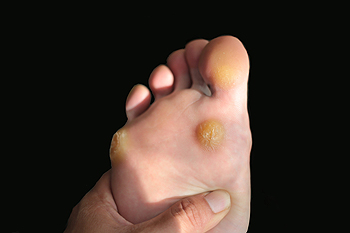 Many people will develop either a corn or callus on their foot at some point in their lives; but what are they? Corns and calluses are areas where the skin has thickened due to constant friction on the area. Corns are smaller and harder than calluses and usually develop on the toes. Calluses, meanwhile, are not usually painful compared to corns and usually occur on the bottom of the foot. Typically, either will go away if the source of friction is taken away. There are some at-home treatments that may help; however, you should consult a podiatrist first to see if they will be effective and appropriate for you. Soaking your feet can soften corns and calluses, as can moisturizers. Over-the-counter pads can help remove both but require caution in their use, as some pads contain salicylic acid—which should be avoided. Finally, one of the most important ways to prevent corns and calluses is to wear fitted and comfortable shoes that prevent friction against the area.
Many people will develop either a corn or callus on their foot at some point in their lives; but what are they? Corns and calluses are areas where the skin has thickened due to constant friction on the area. Corns are smaller and harder than calluses and usually develop on the toes. Calluses, meanwhile, are not usually painful compared to corns and usually occur on the bottom of the foot. Typically, either will go away if the source of friction is taken away. There are some at-home treatments that may help; however, you should consult a podiatrist first to see if they will be effective and appropriate for you. Soaking your feet can soften corns and calluses, as can moisturizers. Over-the-counter pads can help remove both but require caution in their use, as some pads contain salicylic acid—which should be avoided. Finally, one of the most important ways to prevent corns and calluses is to wear fitted and comfortable shoes that prevent friction against the area.
If you have any concerns regarding your feet and ankles, contact Dr. Harry I. Zirna of Lockport Foot Care, PLLC. Dr. Zirna will treat your foot and ankle needs.
Corns: What Are They? and How Do You Get Rid of Them?
Corns can be described as areas of the skin that have thickened to the point of becoming painful or irritating. They are often layers and layers of the skin that have become dry and rough, and are normally smaller than calluses.
Ways to Prevent Corns
There are many ways to get rid of painful corns such as wearing:
- Well-fitting socks
- Comfortable shoes that are not tight around your foot
- Shoes that offer support
Treating Corns
Treatment of corns involves removing the dead skin that has built up in the specific area of the foot. Consult with Dr. Zirna to determine the best treatment option for your case of corns.
If you have any questions please feel free to contact our offices located in Lockport and Medina, NY. We offer the newest diagnostic and treatment technologies for all your foot and ankle needs.
Read more about Corns: What Are They, and How Do You Get Rid of ThemBlog Archives
- March 2024
- February 2024
- January 2024
- December 2023
- November 2023
- October 2023
- September 2023
- August 2023
- July 2023
- June 2023
- May 2023
- April 2023
- March 2023
- February 2023
- January 2023
- December 2022
- November 2022
- October 2022
- September 2022
- August 2022
- July 2022
- June 2022
- May 2022
- April 2022
- March 2022
- February 2022
- January 2022
- December 2021
- November 2021
- October 2021
- September 2021
- August 2021
- July 2021
- June 2021
- May 2021
- April 2021
- March 2021
- February 2021
- January 2021
- December 2020
- November 2020
- October 2020
- September 2020
- August 2020
- July 2020
- June 2020
- May 2020
- April 2020
- March 2020
- February 2020
- January 2020
- December 2019
- November 2019
- October 2019
- September 2019
- August 2019
- July 2019
- June 2019
- May 2019
- April 2019
- March 2019
- February 2019
- January 2019
- December 2018
- November 2018
- October 2018
- September 2018
- August 2018
- July 2018
- June 2018
- May 2018
- April 2018
- March 2018
- February 2018
- January 2018
- December 2017
- November 2017
- October 2017
- September 2017
- August 2017
- July 2017
- June 2017
- May 2017
- April 2017
- March 2017
- February 2017
- January 2017
- December 2016
- November 2016
- October 2016
- September 2016
- August 2016
- July 2016
- June 2016
- May 2016
- April 2016
